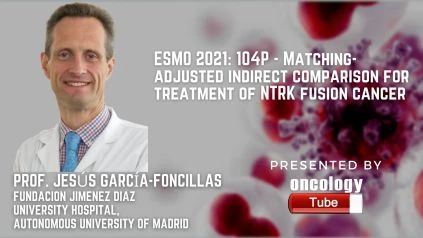Prof. Jesús GarcÃa-Foncillas, MD, Ph.D., is currently the Director of the University Cancer Institute and the Department of Oncology at the “Fundacion Jimenez Diaz” University Hospital (Autonomous University of Madrid, Spain) and Professor of Oncology at the Autonomous University of Madrid. He combines this with the roles of Director of the Translational Oncology Division at the Health Research Institute FJD-UAM (Autonomous University of Madrid, Spain) and Coordinator of the Comprehensive Cancer Program of four University Hospitals at Madrid (Fundacion Jimenez Diaz, Infanta Elena Hospital, Rey Juan Carlos Hospital, and Collado-Villalba Hospital). Prof Garcia-Foncillas obtained his MD from the School of Medicine, University of Zaragoza (Zaragoza, Spain) and was awarded Ph.D. from the University of Navarra (Pamplona, Spain). Speaks about ESMO Abstract 104P – Matching-adjusted indirect comparison for treatment of NTRK fusion cancer with larotrectinib versus entrectinib.
Link to Abstract:
https://s3.eu-central-1.amazonaws.com/m-anage.com.storage.esmo/static/esmo2021_abstracts/104P.html.pdf
Abstract:
Background:
There is a scarcity of data on the efficacy and safety of first-generation therapy for Neurotrophic Tropomyosin Receptor Kinase (NTRK) fusion cancer. Although cross-trial comparisons can be skewed, a matching adjusted indirect comparison (MAIC) can help to balance observable population features and make comparisons between trials easier. Using MAIC, researchers compared larotrectinib and entrectinib.
Methods:
Patient data from larotrectinib trials (LOXO-TRK-14001, SCOUT, and NAVIGATE; data cutoff July 2020) and published aggregate data from entrectinib trials (ALKA-372-001, STARTRK-1, and STARTRK-2; data cutoff October 2018) were used. Patients were matched based on common baseline variables that were available (gender, age, race, ECOG score, select tumor types, metastatic disease, NTRK gene, central nervous system metastases, number of prior lines of therapy). Overall survival (OS), progression-free survival (PFS), overall response rate (ORR), complete response (CR) rate, duration of response (DoR), any major treatment-related adverse events (TRAEs), and TRAEs resulting in treatment discontinuation were all considered important outcomes. Treatments were compared using risk differences (RDs) and hazard ratios (HRs).
Results:
The study included 117 patients from the larotrectinib efficacy group, 147 patients from the larotrectinib safety population, and 74 patients from the entrectinib trials. Larotrectinib had a median follow-up of 16.9 months while entrectinib had a median follow-up of 14.2 months. Larotrectinib was linked to a prolonged OS (p0.05) and numerically longer PFS (p=0.07, Table) after matching. The ORRs were nearly identical (p=0.61). Larotrectinib had a greater CR rate (p0.05) and a longer DoR (p0.05). Both agents had similar and low safety outcomes.
Conclusions:
These findings imply that larotrectinib has a better efficacy (OS, DoR, and CR) in NTRK fusion cancer than entrectinib.

